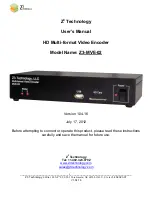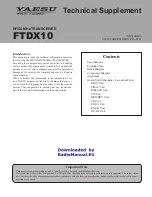
62
DataMover ESS User’s Guide
SIMREX MAN.ESS-01, Rev. F
SIMREX Corporation
Most polled protocols will be best served by UDP service as the protocol
itself has built-in error recovery mechanisms. UDP provides the needed
multidrop operation by means of multicast addressing.
On the other hand, TCP services are best suited for applications that do
not have a recovery mechanism (error-correction) and must have the
guaranteed delivery that TCP provides despite the extra overhead. The
IP-to-Serial example shows how to do this. (
See
“IP-to-Serial Applica-
tion Example”
on Page 72
.)
Serial Encapsulation
Transparent encapsulation, or IP tunneling, provides a mechanism to
encapsulate serial data into an IP envelope. Basically, all the bytes
received through the serial port are put into the data portion of a TCP or
UDP packet (TCP or UDP are user configurable options). In the same
manner, all data bytes received in a TCP or UDP packet are output
through the serial port.
When data is received by the radio through the serial port it is buffered
until the packet is received completely. There are two events that signal
an end-of-packet to the radio: a period of time since the last byte was
received, or a number of bytes that exceed the buffer size. Both of these
triggers are user configurable.
One radio can perform serial data encapsulation (IP-to-Serial) and talk
to a PC. Two radios (or one radio and a terminal server) can be used
together to provide a serial-to-serial channel.
TCP Client vs. TCP Server
On a TCP session there is a server side and a client side. The server is
always waiting for requests from clients. The transceiver can be config-
ured to act as either a server or a client.
The client mode attempts to establish a connection to a server (typically
running on a PC) whenever it receives data on the serial port.
There is also a Client/Server mode where a connection is established in
either the client or server modes. An incoming “keep alive” timer and
outgoing counter
UDP Multicast
IP provides a mechanism to do a limited broadcast to a specific group of
devices. This is known as “multicast addressing.” Many IP routers, hubs
and switches support this functionality.
Multicast addressing requires the use of a specific branch of IP
addresses set apart by the Internet Assigned Numbers Authority (IANA)
for this purpose.
Содержание DataMover ESS
Страница 2: ......
Страница 10: ...2 DataMover ESS User s Guide SIMREX MAN ESS 01 Rev F SIMREX Corporation...
Страница 26: ...18 DataMover ESS User s Guide SIMREX MAN ESS 01 Rev F SIMREX Corporation...
Страница 28: ...20 DataMover ESS User s Guide SIMREX MAN ESS 01 Rev F SIMREX Corporation...
Страница 37: ...SIMREX MAN ESS 01 Rev F DataMover ESS User s Guide 29 SIMREX Corporation...
Страница 127: ...SIMREX MAN ESS 01 Rev F DataMover ESS User s Guide 119 SIMREX Corporation...
Страница 129: ...SIMREX MAN ESS 01 Rev F DataMover ESS User s Guide 121 SIMREX Corporation...
Страница 145: ...SIMREX MAN ESS 01 Rev F DataMover ESS User s Guide 137 SIMREX Corporation...
Страница 156: ...148 DataMover ESS User s Guide SIMREX MAN ESS 01 Rev F SIMREX Corporation...
Страница 158: ...150 DataMover ESS User s Guide SIMREX MAN ESS 01 Rev F SIMREX Corporation...
Страница 172: ...164 DataMover ESS User s Guide SIMREX MAN ESS 01 Rev F SIMREX Corporation...
Страница 180: ...172 DataMover ESS User s Guide SIMREX MAN ESS 01 Rev F SIMREX Corporation...
















































